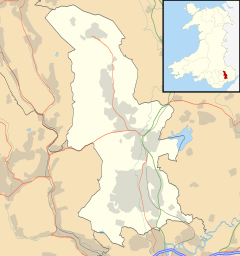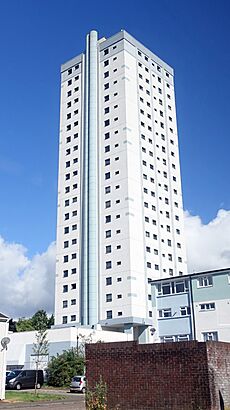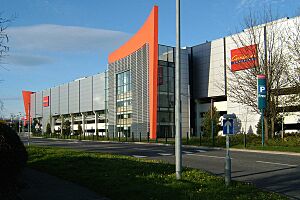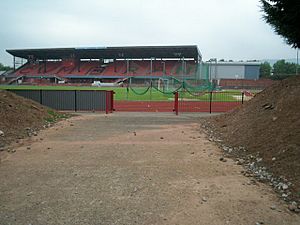Cwmbran facts for kids
Quick facts for kids Cwmbran
|
|
|---|---|
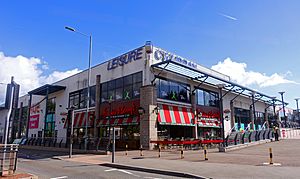 Glyndŵr Road in Cwmbran, photographed in July 2018 |
|
| Population | 48,535 |
| OS grid reference | ST295955 |
| Community |
|
| Principal area |
|
| Ceremonial county | |
| Country | Wales |
| Sovereign state | United Kingdom |
| Post town | CWMBRAN |
| Postcode district | NP44 |
| Dialling code | 01633 |
| Police | Gwent |
| Fire | South Wales |
| Ambulance | Welsh |
| EU Parliament | Wales |
| UK Parliament |
|
| Welsh Assembly |
|
Cwmbran (/kʊmˈbrɑːn, kuːm-/ kuum-BRAHN-,_-KOOM--; Welsh: Cwmbrân [kʊmˈbraːn]) is a town in South Wales. It is part of the Torfaen area.
Cwmbran was named a "New Town" in 1949. This meant it was a specially planned town. Its goal was to create new jobs in the south-eastern part of the South Wales Coalfield.
Contents
Geography of Cwmbran
Cwmbran includes several smaller villages. These are Old Cwmbran, Pontnewydd, Upper Cwmbran, Henllys, Croesyceiliog, Llantarnam, and Llanyrafon. By 2011, its population had grown to 48,535 people. This makes it the sixth largest urban area in Wales.
The town is located at the edge of the South Wales Coalfield. This means its western and northern parts are quite hilly. The hills around Cwmbran can reach over 1,000 feet (300 m) high. The Afon Llwyd is the main river valley. You can also see parts of the old Monmouthshire & Brecon Canal. To the east, the land is flatter. It forms part of the Usk valley.
What Does Cwmbran Mean?
The name of the town comes from the Welsh language. "Cwm" (pronounced 'koom') means "valley." "Brân" (pronounced 'brahn') means "crow." So, Cwmbran means "valley of the crow."
Cwmbran was originally the name of a small village in the valley. This village grew around the tinplate factories of the Cwmbran Iron Company. When the new town was created in 1949, the old village became known as Old Cwmbran.
History of Cwmbran
Cwmbran was officially started in 1949 as a new town. Its main purpose was to bring new jobs to the area. But the land around Cwmbran has a very long history.
People lived here even in ancient times. There is proof that Neolithic (Stone Age) and Bronze Age people used this area. The Iron Age Silures tribe also lived here. Later, the Roman legions from nearby Usk and Caerleon took control.
Around the year 1179, a lord named Hywel gave money and land. This helped to start a Cistercian abbey at Llantarnam. An abbey is a type of monastery. Later, King Henry VIII closed the abbey. Wealthy landowners then bought it. By the 1700s, the Blewitt family owned the abbey. They were very important in starting industries in Cwmbran. During this time, people began making bricks and mining for iron ore and coal. They also built a canal to move goods to the docks in Newport.
In 1833, old maps showed Cwmbran as just a farm. It was in the area now called Upper Cwmbran. Today, Cwmbran covers about 3,000 acres (12 km2). It has a population of around 50,000 people.
In the 1800s and 1900s, Cwmbran became a center for heavy industry. People dug for coal and iron ore on Mynydd Maen. These materials were then moved to factories. Factories like the Patent Nut and Bolt Company made things from metal. There were also tin plate factories and brickworks. These industries led to the building of canals and railways. Today, most of these old industries are gone. Many new shops and light industries are now on these old factory sites.
After World War II, the government wanted to build new homes. Cwmbran was chosen to be a new town in 1949. This helped to create more housing and jobs.
Economy and Jobs
One of the oldest employers in Cwmbran is Burton's Foods. This company makes biscuits like Jammie Dodgers and Wagon Wheels. About 1000 people work there. In 2005, the Cwmbran factory made over 400 million Wagon Wheels each year!
Another big employer is Safran Seats Great Britain. This factory makes seats for airplanes. It also employs about 1000 people.
Cwmbran Centre
The main shopping area is called the Cwmbran Centre. It was built between 1959 and 1981. It's a pedestrian area, meaning no cars are allowed. You can find supermarkets, many shops, banks, a theater, and a cinema here. There's also a bowling alley, restaurants, and a trampoline park. Other facilities include a gym, police station, library, and an arts center.
The Centre has over 170 shops. You can easily get there by bus, as there's a bus station right in the Centre. The train station is also just a short walk away. Plus, there are 3000 free parking spaces around the Centre.
Education in Cwmbran
Cwmbran has two main high schools: Croesyceiliog School and Cwmbran High School. There are also many primary schools and nurseries. One of these is a Welsh-speaking primary school, Ysgol Gymraeg Cwmbrân.
Crownbridge Special School is also in Cwmbran. It helps students aged 2 to 19 years old.
For further education, students can go to the Torfaen Learning Zone. This is part of Coleg Gwent and is located in the Cwmbran Centre.
Sports in Cwmbran
Cwmbran Stadium is a large sports facility. It has an athletics track, a sports hall, a gym, and a swimming pool. It also has an indoor bowling rink.
Athletics
Cwmbran Stadium used to host big athletics events in the 1970s and 1980s. Famous athletes like Colin Jackson (a world champion hurdler) and Jamie Baulch (a world indoor champion runner) trained here. The town has three athletics clubs for people who want to run and train.
Football
Cwmbran has three main football teams: Cwmbran Town, Cwmbran Celtic, and Croesyceilog. They all play in the Welsh Football League. Cwmbran Town and Celtic both play their home games at Cwmbran Stadium.
Rugby Union
The town has three rugby union teams: Cwmbran RFC, Croesyceiliog RFC, and Girling RFC. They play at different grounds around Cwmbran. Many people in Cwmbran also support the rugby teams from nearby towns like Pontypool and Newport. They also support the regional team, the Newport Gwent Dragons.
Rugby League
Rugby league is also played in Cwmbran. The team is called Torfaen Tigers. They play their home games at the Kings Head Ground.
Media and News
The main newspaper for the area is the South Wales Argus. There is also a Welsh national newspaper called the Western Mail. You can read its digital version online as Wales Online. Cwmbran also has its own local news service called Cwmbran Life.
Some online and amateur radio stations operate in Cwmbran. Vitalize Radio is a community radio station for the Torfaen area. There is also the Cwmbran and District Amateur Radio Society. Able Radio helps adults with autism and learning disabilities.
In 2011, the comedy music group Goldie Lookin Chain released a song called "Fresh Prince of Cwmbran." It was a funny song praising the town.
Getting Around Cwmbran
Trains
Cwmbran railway station has trains that go south to Newport and Cardiff. Northbound trains go to Pontypool and Abergavenny. You can also take longer trips to places like Hereford and Manchester. The station only opened in 1986. Before that, Cwmbran had no train service for 24 years.
Buses
Cwmbran has a good bus service from Cwmbran bus station. Newport Bus and Stagecoach South Wales operate most of the routes. You can take buses to nearby towns and cities like Newport, Blaenavon, and Cardiff. Stagecoach has updated its buses with newer models for many routes. Phil Anslow Coaches is a local company that also runs bus services in the town.
Partner Cities
Cwmbran has a partner city in Germany. It is Bruchsal in Baden-Württemberg.
Famous People from Cwmbran
- Sioned Williams (born 1971) – A politician in the Welsh Parliament.
- John Williams (born 1857, died 1932) – A hero from the Zulu War who won the Victoria Cross.
- Margaret Price (born 1941, died 2011) – A famous opera singer.
- Green Gartside (born 1955) – The singer for the band Scritti Politti.
- Andy Dibble (born 1965) – A professional football player.
- Lee Dainton (born 1973) – A TV presenter, known for Dirty Sanchez.
- Ceri Dallimore (born 1974) – A gold medal winner in shooting at the Commonwealth Games.
- Ian Gough (born 1976) – A professional rugby player for Wales.
- Gary Lockett (born 1976) – A professional boxer and TV analyst.
- Helen Adams (born 1978) – A contestant and TV presenter from Big Brother.
- Danny Gabbidon (born 1979) – A professional football player for Cardiff City and Wales.
- Jamie Arthur (born 1979) – A medal-winning boxer at the Commonwealth Games.
- Rachel Rice (born 1984) – A contestant from Big Brother.
- Christian Doidge (born 1992) – A professional football player.
- Nick Kenny (born 1993) – A professional darts player.
- Jak Jones (born 1993) – A professional snooker player.
- Dave Richards (born 1993) – A professional football player.
- Theo Wharton (born 1994) – A football player who played for Wales youth teams.
- Kim & Michael Davies – Champions from the TV show Robot Wars UK with their robot, Panic Attack.
- Connor Edwards (born 1997) – A professional rugby player.
- Cory McKenna (born 1999) – A professional mixed martial artist.
Places to See in Cwmbran
- Congress Theatre
- Cwmbran Boating Lake Park
- Cwmbran Leisure
- Cwmbran Town Centre
- Cwmbran Retail Park
- Cwmbran Stadium
- Five Locks along Monmouthshire and Brecon Canal
- Greenmeadow Community Farm
- Henllys local nature reserve
- Llantarnam Grange Arts Centre
- Llanyrafon Manor - Rural Heritage Centre
See also
In Spanish: Cwmbran para niños


